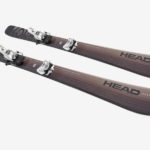As someone who has been skiing and snowboarding for years, I understand the importance of having a reliable and comfortable helmet on the slopes.

With so many options available, it can be overwhelming to choose the right one.
That’s why I’ve decided to share my experience with two popular helmet models: Smith Level and Vantage.
Below, I’ll compare these helmets to help you make a well-informed decision for your next ski or snowboarding trip, so let’s dive right in.
Smith Level vs. Vantage: Safety Certification
The Smith Level helmet is certified by ASTM International and CE (Conformité Européenne), two leading organizations that set standards for protective equipment.
ASTM International is a globally recognized organization that develops and publishes technical standards for various materials, products, systems, and services.
CE is a European regulatory body that mandates that certain products, including ski helmets, meet specific safety requirements before being sold in the European market.
The Vantage helmet, on the other hand, is certified by ASTM International only.
However, this certification is equally reliable and recognized worldwide, ensuring the helmet meets the minimum safety standards required to protect your head from injuries in a fall or collision.
In conclusion, they’re both certified by reputable safety organizations, so they meet the necessary safety standards for skiing. But if you plan to ski in the European market, the Smith Level’s additional CE certification may be advantageous.
Smith Level vs. Vantage: Fit and Comfort
The Vantage helmet features a Hybrid SL shell construction, which combines a lightweight in-mold lower shell with a durable ABS upper shell.
The helmet has a 360-degree Boa fit system for a snug fit.
The helmet’s lining is also made of a soft, moisture-wicking material that helps keep you dry and comfortable.
The helmet also features a removable ear pad and chin strap, allowing customized fit and added warmth on cold days.
Both helmets offer great fit and comfort, but the Smith Level helmet’s MIPS technology and 3-layer foam system provide added protection and comfort.
However, the Vantage helmet’s Hybrid SL shell construction and removable ear pad and chin strap allow for more customization and warmth options.
Ultimately, the right choice will depend on personal preferences and fit.
Smith Level vs. Vantage: Ventilation
Proper ventilation matters for ski helmets, as it helps regulate temperature and prevent overheating.
The Smith Level helmet features a dual regulator climate control system, which allows you to adjust the helmet’s vents for optimal temperature control.
The helmet has 20 vents in total, including six adjustable vents, four static vents, and ten vents in the helmet’s interior.
This allows for customized airflow and helps prevent goggle fogging.
The Vantage helmet also features a customizable ventilation system with 21 total vents.
The helmet has adjustable vents on the top and sides of the helmet, allowing you to regulate the temperature as needed.
The helmet’s interior also features a moisture-wicking liner that helps keep you dry and comfortable.
Both helmets offer great ventilation and climate control, with a similar number of vents and customizable options.
However, the Smith Level helmet’s dual regulator system may provide slightly more control over airflow.
Smith Level vs. Vantage: Weight
Weight is a crucial factor to consider when choosing a ski helmet, as a heavy helmet can be uncomfortable and may cause neck strain.
The Smith Level helmet is lightweight, with a low profile that reduces bulk.
The helmet weighs in at just over 16 ounces (450 grams), making it one of the lightest helmets on the market.
The Vantage helmet is slightly heavier, weighing just under 19 ounces (540 grams).
However, the helmet’s Hybrid SL shell construction allows for lighter weight without sacrificing durability or protection.
Overall, both helmets offer relatively lightweight options, with the Smith Level helmet being the lighter.
However, the Vantage helmet’s slightly heavier weight may benefit those seeking additional durability and protection.

Smith Level vs. Vantage: Compatibility
When choosing a ski helmet, it’s important to ensure its compatible with your other gear, including your goggles and audio devices.
The Smith Level helmet features AirEvac ventilation, which helps prevent goggle fogging by ensuring air flows between the goggles and helmet.
The helmet is also designed to be compatible with Smith goggles, offering seamless integration between the two products.
Additionally, the helmet has a removable goggle lock that can secure your goggles when not in use.
The Vantage helmet also features AirEvac ventilation, with a design that maximizes airflow between the goggles and helmet to prevent fogging.
The helmet is compatible with most standard goggles, and the helmet’s shape allows for a seamless fit with various goggles.
The helmet also has a great audio-compatible ear pad system that allows easy audio device integration.
Both helmets offer solid compatibility features, with the Smith Level helmet offering more seamless integration with Smith goggles and a removable goggle lock.
The Vantage helmet’s audio-compatible ear pads may benefit those seeking to use audio devices while skiing.
Smith Level vs. Vantage: Durability
Smith Level has a lightweight in-mold construction, meaning the fused shell and foam liner create a single, durable unit.
This construction method results in a lightweight and strong helmet, making it a great choice for skiers and snowboarders who want a protective and comfortable helmet.
Vantage, on the other hand, typically has a hard shell and foam liner.
While this construction method can provide excellent protection against impacts, it can also make the helmet heavier and less comfortable for extended periods.
Smith Level vs. Vantage: Style and Color

Smith Level helmets come in various colors and designs, including matte black, white, and bright colors like orange and green.
They also offer several different helmet styles, such as the Level, Level MIPS, and Level Asian Fit, each with unique design features and color options.
Vantage helmets also offer a range of colors and designs, including classic solid colors like black and white and bold patterns and graphics.
They provide several helmet styles, such as Classic, Legend, and BRIGADE, each with distinct look and color options.
Smith Level vs. Vantage: Price
Smith Level helmets typically cost between $130 and $280, depending on the specific model and features.
The higher-end models, such as the Level MIPS, tend to be more expensive due to the additional safety features.
Vantage helmets, on the other hand, cost between $60 and $150. However, this doesn’t necessarily mean they offer less protection, as Vantage helmets meet safety standards and provide reliable protection.
Ultimately, the choice between Smith Level and Vantage helmets based on price will depend on your budget and personal preferences.
If you’re looking for a helmet with advanced safety features and don’t mind the higher price, then Smith Level may be the better option.
However, Vantage may be better if you want a more affordable, reliable helmet.
Smith Level vs. Vantage: Closing Thoughts
After a thorough comparison, it’s clear that the Smith Level and Vantage helmets have their strengths and weaknesses.
Ultimately, the right choice for you will depend on your personal preferences and the type of skiing or snowboarding you enjoy.
As someone who has used both helmets, I can attest to their comfort, protection, and reliability on the slopes.
I hope this article has helped you better understand these two popular helmet models and provided you with the information you need to make a confident decision for your next winter adventure.
Always prioritize safety and comfort when selecting ski or snowboarding equipment.

I was working as a mountain guide, probably all around the planet. One day, I met my wife in the mountains, literally on top of the world. Now, I have a beautiful family and three kids, so I don’t have much time for climbing, but sometimes I go camping with my friends. I am also into gym workouts, and I can’t imagine my life without sports.
Since I ended my professional career as a climbing guide, I’ve been giving personal classes and helping amateurs to get ready for conquering their first peaks. Also, that’s how the whole blog idea appeared.





